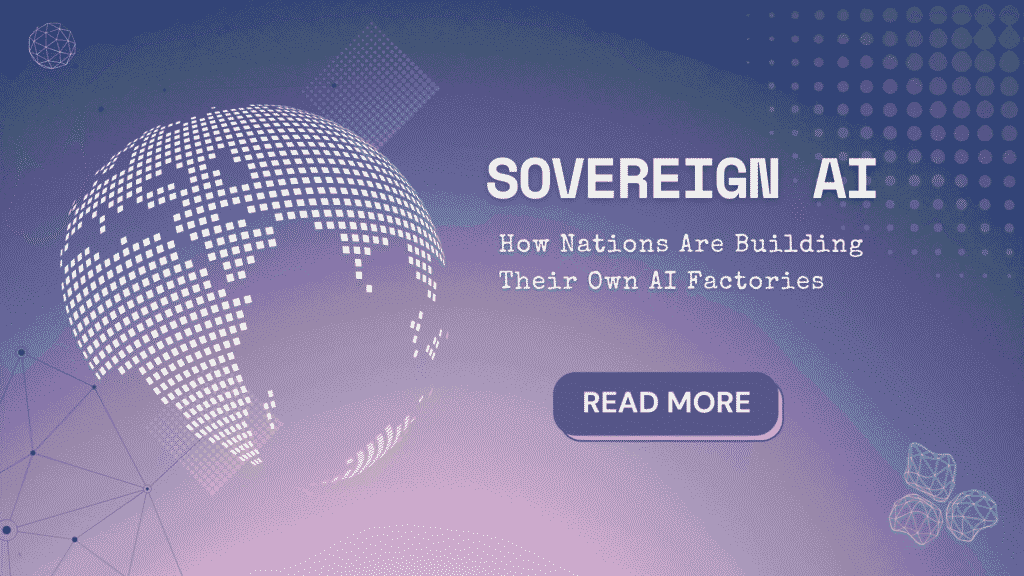Sovereign AI Explained: How Nations Are Building AI Factories for Power and Control

Imagine a world where every country builds its own AI powerhouse which is complete with data centers, language models, and cutting-edge chips. That’s the vision behind Sovereign AI, a movement where nations aim to control their own artificial intelligence infrastructure. It’s not just about tech, it’s about independence, security, and economic growth.
But why are countries so eager to claim their slice of the AI pie? Let’s break it down.
Table of Contents
Why Are Countries Racing Toward Sovereign AI?
Governments are diving into sovereign AI for three key reasons:
- Data Privacy: Keeping sensitive data like health and financial records within national borders helps protect citizens and comply with local laws.
- Security: AI has military and intelligence applications. Relying on foreign platforms can be risky, so countries want to build their own secure systems.
- Economic Growth: AI can revolutionize industries. By investing in domestic AI, countries create jobs, support startups, and tailor models to local languages and needs.
Global Momentum
From India and France to Japan and the UAE, governments are racing to build their own AI infrastructure. And one name keeps popping up in almost all these efforts: NVIDIA.
France: France has declared AI a national priority. At VivaTech, one of the world’s biggest technology conferences, President Emmanuel Macron called building AI infrastructure “our fight for sovereignty.” That statement perfectly captures France’s approach. AI isn’t just a tool; it has become a matter of national independence. Thus, the country is backing startups like Mistral AI, which is building a massive supercomputer using 18,000+ NVIDIA GPUs. Companies like Scaleway and Orange Business are also rolling out NVIDIA’s cutting-edge chips in European data centers.
Germany: Germany is taking a factory-first approach to AI. In partnership with Deutsche Telekom, NVIDIA is building the world’s first industrial AI cloud, right in Germany. This cloud is tailor-made for Europe’s manufacturing giants, and it’s powered by 10,000 NVIDIA Blackwell GPUs, running on DGX B200 systems and NVIDIA RTX PRO Servers. This AI “factory” is designed to supercharge everything from design and engineering to simulation, digital twins, and robotics, core strengths of Germany’s industrial economy. It’s also the single largest AI deployment in Germany’s history, and a flagship example of how AI infrastructure is becoming as vital as electricity or broadband.
UAE: The UAE is going massive. Its Stargate AI Campus in Abu Dhabi is set to become one of the world’s largest AI hubs, with NVIDIA’s most powerful chips at the core. They are also backed up by tech giants like Oracle and OpenAI. Phase one alone will use enough computing power to light up a small country.
Japan: Japan government is pumping hundreds of millions of dollars into local AI infrastructure. Big players like SoftBank and KDDI are building NVIDIA-powered supercomputers to train models in Japanese and other local languages.
South Korea: South Korea’s web giant Naver is leading the charge with its own language model, HyperCLOVA X, built entirely in Korean and run on domestic cloud systems. With NVIDIA tech behind the scenes, this is another strong example of how sovereign AI is taking cultural shape.
These are just a few of the countries making bold moves in the world of sovereign AI. From Europe to Asia, the global AI map is quickly getting redrawn. But now, let’s turn our attention to India, a country with ambitious AI dreams and a long-standing legacy of excelling in the world of technology.
India’s Bold AI strategy
India is making waves with its ambitious IndiaAI Mission, investing over ₹10,000 Cr to build a robust AI ecosystem. The country has deployed over 34,000 GPUs, including NVIDIA H100/H200, through a common computing platform that offers affordable access to researchers and startups. Projects like BharatGen and Sarvam AI are creating multilingual models tailored to Indian languages and contexts. India-based Tata Group is building large-scale AI infrastructure powered by the NVIDIA GH200 Grace Hopper Superchip, while Reliance Industries is developing a foundational large language model (LLM) tailored for generative AI and trained on the diverse languages of the world’s most populous nation.
So… What’s So Special About NVIDIA?
If you’re wondering why NVIDIA shows up in every country’s AI playbook, it’s because they make the world’s most powerful AI chips. Originally known for designing high-performance graphics cards for gaming, NVIDIA now dominates the AI space with its GPU (Graphics Processing Unit) technology, which is essential for training and running large AI models. Their latest chips, like the H100, H200, and GH200 Grace Hopper, are used to power everything from self-driving cars to national AI clouds. While there are other players like AMD, Intel, and newer startups, NVIDIA is still far ahead in terms of both hardware performance and its full-stack AI ecosystem.
The Road Ahead
For years, AI felt like the domain of Silicon Valley giants, Google, Microsoft, OpenAI which are mostly rooted in the U.S. But that era is changing fast. Sovereign AI has become a rallying cry across continents, and nations are no longer content to be passive users of foreign technology. From Europe’s industrial powerhouses to Asia’s language-rich innovators, AI is no longer the privilege of a few, it’s becoming a national asset everywhere.
What we’re witnessing is a global awakening: AI is the new infrastructure, and every country wants to own a piece of it. No longer is innovation confined to a handful of labs in California. Instead, it’s taking root in data centers in Gujarat, Tokyo, Abu Dhabi, and Paris. The age of global AI independence has begun and this time, the map is wide open.